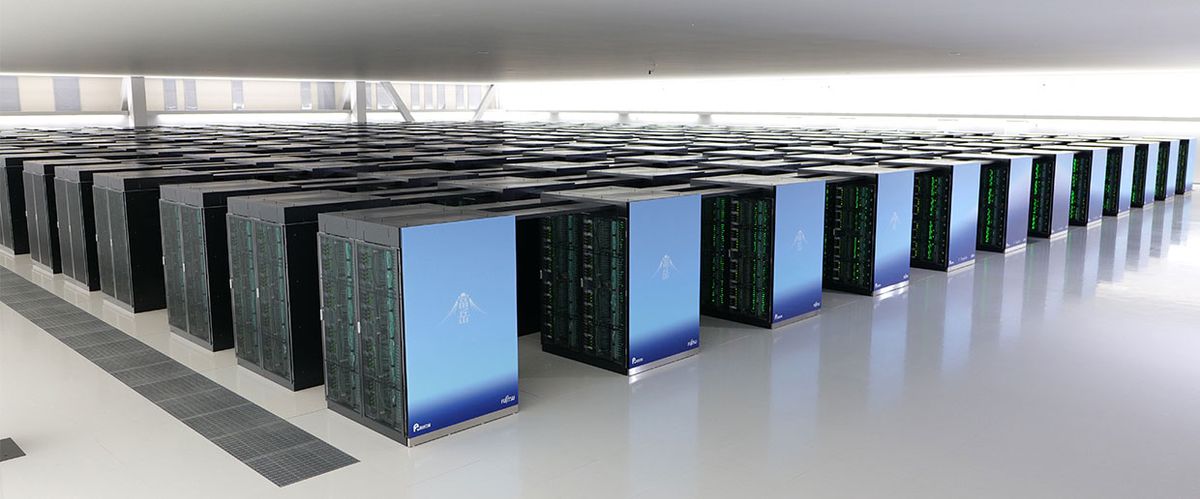The public-private partnership Fujitsu and national research institute RIKEN put Japan on top of the world supercomputer rankings nine long years ago with the K computer. They’ve done it again, and in spades, with their jointly developed Fugaku supercomputer.
Fugaku, another name for Mount Fuji, sits at the summit of the TOP500 list announced on 22 June. It earned the top spot with an extraordinary performance of 415 Linpack petaflops. This is nearly triple that of the runner-up and previous No. 1, Oak Ridge National Lab’s Summit supercomputer in Tennessee, built by IBM. Fugaku achieved this using 396 racks employing 152,064 A64FX Arm nodes. The Arm components make up approximately 95 percent of the computer’s almost 159,000 nodes.
In addition to demonstrating world-beating speed, Fugaku beat the competition in the High Performance Conjugate Gradients (HPCG) benchmark used to test real-world application performance; the Graph500, a rating for data-intensive loads; and HPL-AI, a benchmark for rating artificial-intelligence workloads. A Fugaku prototype also took top spot for the most energy-efficient system on the Green500 list last November, achieving an outstanding 16.9-gigaflops-per-watt power efficiency during a 2.0-Pflops-per-second Linpack performance run.
Driving Fugaku’s success is Fujitsu’s 48-core Arm v8.2-A A64FX CPU, which the company is billing as the world’s first CPU to adopt Scalable Vector Extension—an instruction-set extension of Arm v8-A architecture for supercomputers. The 512-bit, 2.2-GHz CPU employs 1,024-gigabytes-per-second 3D-stacked memory and can handle half-precision arithmetic and multiply-add operations that reduce memory loads in AI and deep-learning applications where lower precision is admissible. The CPUs are directly linked by a 6.8-GB/s network Tofu D interconnect that uses a 6-dimensional mesh torus connection.
During three years of planning the computer starting in 2011, a number of designs and architectures were considered. “Our guiding strategy was to build a science-driven, low-powered machine that was easy to use and could run science and engineering applications efficiently,” says Toshiyuki Shimizu, principal engineer of Fujitsu’s Platform Development Unit.
Independent observers say they succeeded in every element of the goal. “Fugaku is very impressive with over 7 million cores,” says Jack Dongarra, director of the Innovative Computing Lab at the University of Tennessee, Knoxville. “The machine was designed for doing computational science problems from the ground up. It’s a first.”
As for the choice of Arm architecture, Shimizu notes the large number of application developers supporting Arm. “Fugaku also supports Red Hat Enterprise Linux 8.x, a de facto standard operating system widely used by commercial servers,” he points out.
Another plus for Fugaku is that it follows the K computer by maintaining an all-CPU design. Shimizu says this makes memory access and CPU interconnectivity more efficient. Most other supercomputers rely on graphic processing units (GPUs) to accelerate performance.
Dongarra points out an additional benefit here: “A CPU-only system simplifies the programming. Just one program is needed, not two: One for the CPU and one for the GPU.”
Designing and building a computer that, from the ground up, was intended to be Japan’s national flagship didn’t come cheap, of course. The government’s estimated budget for the project’s R&D, acquisitions, and application development is 110 billion yen (roughly US $1 billion).
Fujitsu dispatched the first units of Fugaku to the RIKEN Center for Computational Science (R-CCS) in Kobe last December, and shipments were completed last month.
Speaking at the ISC 2020 conference in June, Satoshi Matsuoka, director of R-CCS, said that although Fugaku was scheduled to start up next year, Japan’s government decided it should be deployed now to help combat COVID-19. He cited that it was being used to study how the virus behaves, what existing drugs might be repurposed to counter it, and how a vaccine could be made.
Other government-targeted application areas given high priority include disaster-prevention simulations of earthquakes and tsunami; development of fundamental technologies for energy creation, conversion, and storage; creation of new materials to support next-generation industries; and development of new design and production processes for the manufacturing industry.
Fugaku will also be used to realize the creation of a smarter society, dubbed Society 5.0, “that balances economic advancement with the resolution of social problems by a system that highly integrates cyberspace and physical space.”
But the supercomputer industry is nothing if not a game of technology leapfrog, with one country or enterprise providing machines with the highest performance only to be outpaced a short time later. Just how long will Fugaku stay No. 1?
Shimizu doesn’t claim to know, but he says there is room for further improvement of Fugaku’s performance. “The TOP500 result was only 81 percent of peak performance, whereas the efficiency of silicon is higher. We believe we can improve the performance in all the categories.”
But even that might not be enough to keep it on top for long. As Dongarra says, “The U.S. will have exascale machines in 2021.”


